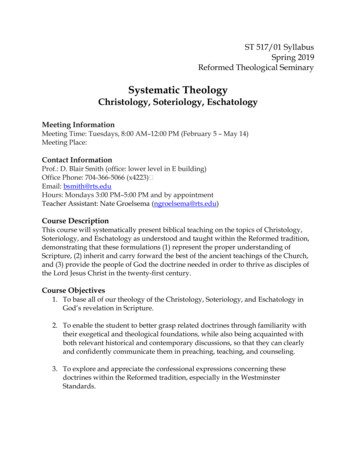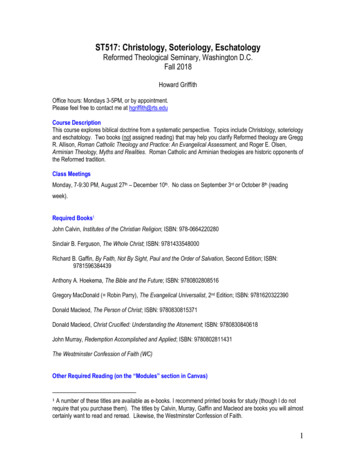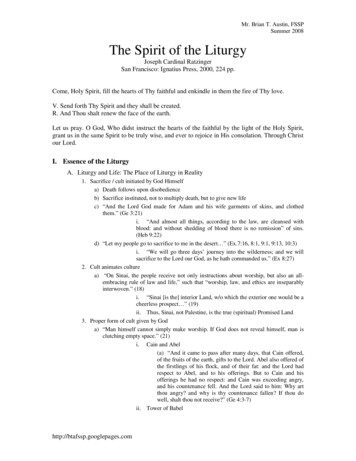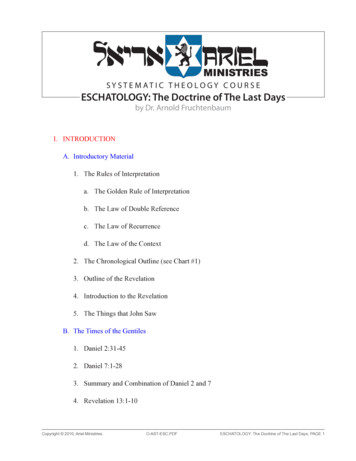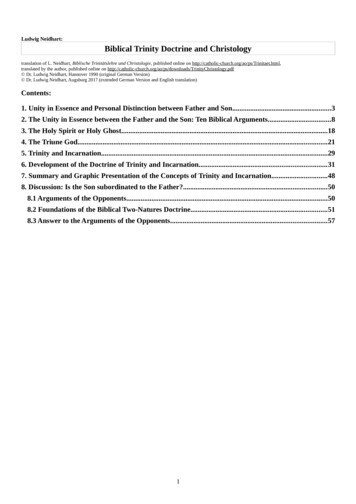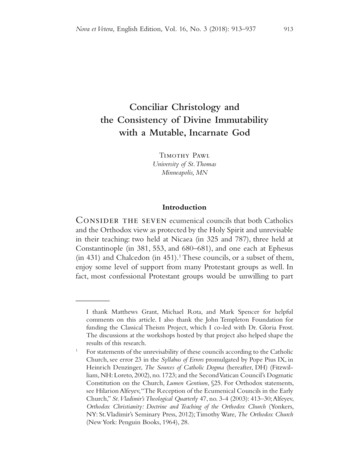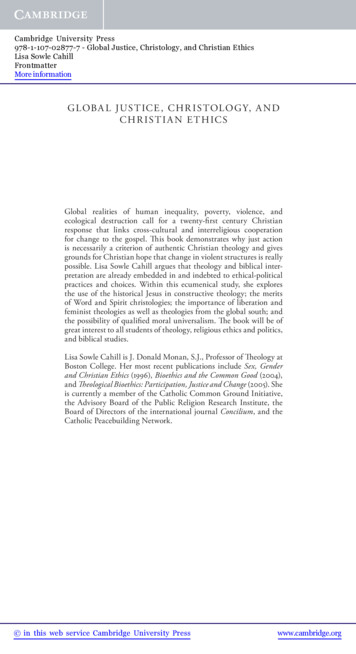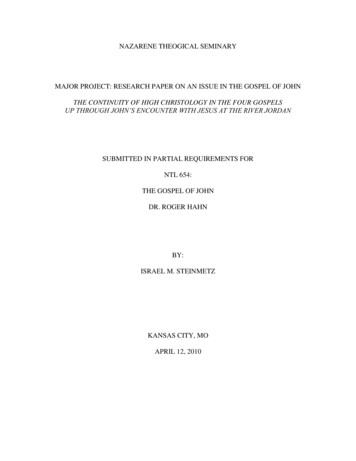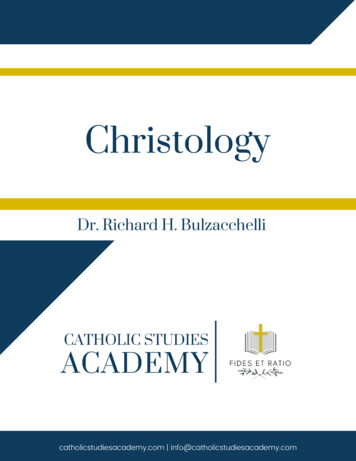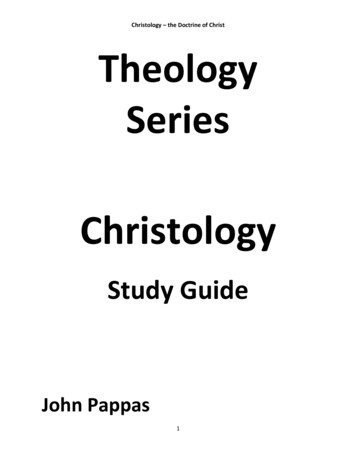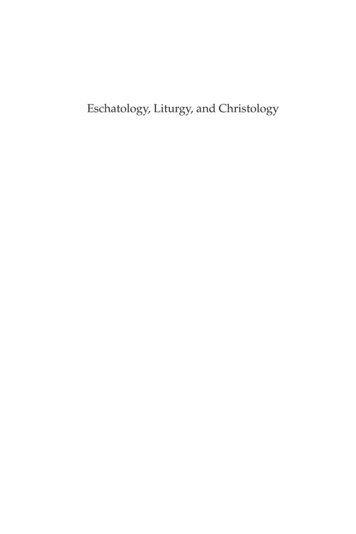
Transcription
Eschatology, Liturgy, and Christology
Eschatology, Liturgy,and ChristologyToward Recoveringan Eschatological ImaginationThomas P. Rausch, SJA Michael Glazier BookLITURGICAL PRESSCollegeville, Minnesotawww.litpress.org
A Michael Glazier Book published by Liturgical PressCover design by AnnBlattner. The Last Judgment by Fra Angelico, ca. 1400–1455.Excerpts from the English translation of The Roman Missal 2010, InternationalCommission on English in the Liturgy Corporation. All rights reserved.Excerpts from documents of the Second Vatican Council are from Vatican CouncilII: The Basic Sixteen Documents, by Austin Flannery, OP 1996 (Costello Publishing Company, Inc.). Used with permission.Scripture texts in this work are taken from the New American Bible with RevisedNew Testament and Revised Psalms 1991, 1986, 1970 Confraternity of ChristianDoctrine, Washington, DC, and are used by permission of the copyright owner.All Rights Reserved. No part of the New American Bible may be reproduced inany form without permission in writing from the copyright owner. 2012 by Order of Saint Benedict, Collegeville, Minnesota. All rights reserved.No part of this book may be reproduced in any form, by print, microfilm, microfiche, mechanical recording, photocopying, translation, or by any other means,known or yet unknown, for any purpose except brief quotations in reviews,without the previous written permission of Liturgical Press, Saint John’s Abbey,PO Box 7500, Collegeville, Minnesota 56321-7500. Printed in the United Statesof America.12345678Library of Congress Cataloging-in-Publication DataRausch, Thomas P.Eschatology, liturgy, and christology : toward recovering aneschatological imagination / Thomas P. Rausch.p. cm.“A Michael Glazier book.”Includes bibliographical references and index.ISBN 978-0-8146-5735-5 — ISBN 978-0-8146-8051-3 (e-book)1. Hope—Religious aspects—Catholic Church. 2. Eschatology.3. Imagination—Religious aspects—Catholic Church. 4. CatholicChurch—Doctrines. I. Title.BV4638.R38 2012236—dc23 2011051285
ForJohn D. McAnulty, SJIn Memoriam
ContentsAcknowledgments ixList of Abbreviations xIntroduction xi1. The Eschatological Imagination 1From Easter Hope to Fear of JudgmentThe Second Vatican Council6Postconciliar Developments7Looking AheadConclusion417272. The God of Israel 29The Gods of the NationsIsrael’s God3031Imagining God’s SalvationConclusion37463. The Way of Jesus 49Following Jesus 50The Imitation of Christ57Modernity and the Solitary Self59Retrieving the Kingdom of God62Contemporary Expressions of the Kingdom of GodConclusion7072vii
viiiEschatology, Liturgy, and Christology4. The Mystery of the Resurrection 75The ResurrectionThe Risen Body7681Resurrection Immediately after Death?85The Basis of Our Eschatological Hope88The Social Nature of the Resurrection91Conclusion975. The Eschata and the Eschaton 99The Soul99The Eschata 102The Eschaton 114Conclusion1216. Eschatology and Liturgy 123Liturgical Time and Memory 124Liturgy and Social Justice130Retrieving the Eschatological ImaginationConclusion1397. Eschatology, Christology, and Church 141From Imagination to UnderstandingChristology143Church and Mission153Some Concluding ReflectionsIndex 163158141132
AcknowledgmentsI would like to acknowledge those who have been of help in preparingthis manuscript. Hans Christoffersen, editorial director at LiturgicalPress, first suggested that I do a book on eschatology. Bruce Morrill wasmost helpful with suggestions when I was preparing a course on liturgyand ecclesiology that provided some of the background. MichaelDowney, a friend and colleague of many years, read and critiqued themanuscript. Eric Christensen did the copyediting with great care. Myresearch assistant Melanie Nguyen was a great help in checking the pageproofs.A number of friends and colleagues reviewed particular chapters oroffered suggestions, among them Christopher Chapple, John Baldovin,James Fredericks, and Saba Soomekh. For their help I am grateful. Theinterpretation remains my own.For occasional lapses from the use of inclusive language in speakingof God, especially in citing other authors or texts, I ask the reader’sindulgence.Thomas P. Rausch, SJix
AbbreviationsDocuments of the Second Vatican CouncilGSLGSCGaudium et Spes (Pastoral Constitution on the Church in theModern World)Lumen Gentium (Dogmatic Constitution on the Church)Sacrosanctum Concilium (Constitution on the Sacred Liturgy)OtherCDFDSFABCxCongregation for the Doctrine of the FaithDenzinger-Schönmetzer, Enchiridion Symbolorum, 33rd ed.(Freiburg: Herder, 1965)Federation of Asian Bishops’ Conferences
IntroductionWhat is our hope as Christians? To what do we look forward? DoesGod forget the countless victims of history? What about our beloveddead? What future does God have in store for us? Will it involve ourbeautiful earth? To raise these questions is to ask about eschatology, theend times, from the Greek eschatos, the “last” or “end.” We look forwardto the eschaton, the coming of the age of salvation.Eschatology should occupy a central place in our Christian faith; without it we have no hope. In Karl Barth’s words, “if Christianity be notaltogether thoroughgoing eschatology, there remains in it no relationshipwhatever with Christ.”1 A library catalogue search reveals multitudinousvolumes dealing with eschatology. Many, written from a conservativeevangelical perspective, speculate about the second coming of Christ,resulting in a proliferation of millennial theologies—premillennial, amillennial, postmillennial—rooted in Revelation 20, which anticipates athousand-year period in which Satan will be confined in the abyss andthe saved will reign with Christ.2 Fundamentalists like Tim LaHaye andJerry Jenkins, authors of the popular Left Behind series, imagine the Rapture when Christ returns to take up the “saved” before the Tribulation(cf. 1 Thess 4:17), with Catholics among those left behind.3On the theological left, eschatology is too often reduced to an empowering symbol or a utopian vision of justice and peace in this world. Those1. Karl Barth, The Epistle to the Romans (London: Oxford University Press, 1933),314.2. See Hans Schwarz, Eschatology (Grand Rapids, MI: William B. Eerdmans, 2000),322–37.3. See Carl E. Olson, Will Catholics Be “Left Behind”? A Catholic Critique of the Raptureand Today’s Prophecy Preachers (San Francisco: Ignatius, 2003).xi
xiiEschatology, Liturgy, and Christologyin the late Robert Funk’s Jesus Seminar have tried to promote the ideaof a noneschatological Jesus.4 Others doing theology today in the newcontext of religious pluralism have challenged traditional positions inthe areas of Christology, soteriology, and the mission of the church. Whilemuch of their work has been fruitful for theology, at the same time thereare methodological turns or conclusions that have significant implications for Christian eschatology and raise some troubling questions. Someare hesitant to affirm Jesus’ divinity or his role in bringing the eschaton.He becomes one of a number of mediators of salvation, not the one whoaccomplishes our salvation. The church’s mission becomes one of witnessing to the kingdom of God.5 Others like John Polkinghorne, theoretical physicist and Anglican priest, focus on eschatology in an effortto bring science and religion together.6In systematic theology, eschatology does not always get the attentionit deserves. Dermot Lane calls it “the missing link in much contemporarytheology.”7 Still less have those theologians who do stress eschatologybeen concerned with its relation to the Eucharist; nor have liturgistsalways been attentive to this relationship, as a review of the indexes ofmany books on liturgy indicates. Among those theologians and liturgistsattentive to the eschatological dimensions of the Eucharist, I would include Dermot Lane, Johann Baptist Metz, Bruce Morrill, John Reumann,Don Saliers, Geoffrey Wainwright, and Joseph Ratzinger, now PopeBenedict XVI. We will draw on their works.At the heart of Christian eschatology is the idea of the resurrection ofthe dead, based on the resurrection of Jesus. The 2006 Faith Matterssurvey found that 70 percent of Americans believe in the afterlife,8 butfor many of them, their idea of life beyond death is vague and undefined,more of a cultural idea about spiritual survival than something based4. See, for example, Marcus J. Borg, Jesus in Contemporary Scholarship (Valley Forge,PA: Trinity Press International, 1994), 7–8.5. Some of these are explored as early as 1976 in J. Peter Schineller, “Christ andChurch: A Spectrum of Views,” Theological Studies 37/4 (1976): 545–66.6. John C. Polkinghorne, The God of Hope and the End of the World (New Haven, CT:Yale University Press, 2002).7. Dermot A. Lane, Keeping Hope Alive: Stirrings in Christian Theology (New York:Paulist, 1996), 5; for a survey of eschatology in twentieth-century theology, seeSchwartz, Eschatology, 107–72.8. Robert D. Putnam and David E. Campbell, American Grace (New York: Simonand Schuster, 2010), 71.
Introduction xiiion the biblical idea of the resurrection of the body and all its implications.Even many Christians think of the resurrection solely in personal terms.Salvation has been understood individualistically; we speak of “savingmy soul,” “going to heaven,” or “being saved.”Too often in our Western culture the hoped-for eschaton has been replaced by an almost exclusive emphasis on the eschata, the “four lastthings” each of us must one day face—death and judgment, heaven andhell. But eschatology cannot be reduced to the salvation of the individualor limited to the saved. Many have lost sight of what James Alison calls“the fullness of the density of the resurrection,”9 a wonderful way ofsuggesting how much is embraced by the mystery of our salvation, theproper object of the study of eschatology. They do not see how the earthitself might be included in God’s salvation. Jürgen Moltmann says that“if Christian hope is reduced to the salvation of the soul in a heavenbeyond death, it loses its power to renew life and change the world, andits flame is quenched.”10Karl Rahner argues that individual eschatology can be complete onlyif a collective eschatology is developed, one that includes the world andits history.11 For the early Christians, God’s future was a radically socialreality; God’s salvation was revealed in the resurrection of Jesus andalready present initially in the gathering (ekklesia, “church”) of the saints,particularly in their worship. It meant the age of salvation, gathering allthe elect into the new creation, had already begun. The expectant faithof the early Christians was evident especially when they celebrated theEucharist, what Paul calls in 1 Corinthians 11:20 “the Lord’s supper,”proclaiming the final coming of the crucified Jesus, now raised and madeLord: “For as often as you eat this bread and drink the cup, you proclaimthe death of the Lord until he comes” (1 Cor 11:26).Thus, one cannot write about eschatology without also addressingissues involving Christology, soteriology, the mission of the church, andthe liturgy. We will have to consider what eschatology suggests aboutour salvation, both now and in the world to come. In what sense can wesay that salvation is already present within history rather than beyond9. James Alison, Raising Abel: The Recovery of the Eschatological Imagination (NewYork: Crossroad, 1996), 28.10. Jürgen Moltmann, The Coming of God: Christian Eschatology (Minneapolis: Fortress, 1996), xv.11. See Karl Rahner, Foundations of Christian Faith (New York: Seabury, 1978),444–45.
xivEschatology, Liturgy, and Christologyit, pace Joseph Ratzinger / Pope Benedict XVI, and can salvation, symbolized by the kingdom of God, be so easily separated from the person ofJesus the Christ, as Roger Haight and others suggest? How should weunderstand the resurrection of the body and a related concept, the immortality of the soul? Can the soul exist without the body? What is therelation between eschatology and creation? Can we say that Jesus is thecause of salvation? And can the mission of the church be reduced towitnessing to the kingdom of God without abandoning the Christianconfession that Jesus is the way, the truth, and the life (cf. John 14:6)? Wewill explore some of these questions in this book.Taking our point of departure from the testimony of the Scripturesand the faith of the church, we will rely on contemporary authors to helpus imagine and better understand the mystery of God’s future, disclosedor suggested by the story of Jesus and his preaching of the kingdom ofGod. Methodologically, our approach could be described as “postcritical,” after the example of Avery Dulles.12 We will attempt to navigatebetween a rationalism that limits knowledge to what science or a postmodern mentality finds acceptable and a biblical literalism that confusesthe symbol with the intelligibility it seeks to express.Finally, I want to call attention to an observation made by RussianOrthodox theologian Sergius Bulgakov. He points out that apart fromthe Nicene Creed’s confession of belief in Christ’s coming again in gloryto judge the living and the dead, the resurrection of the body, and thelife of the world to come, eschatological theology remains open to inquiry. Cautioning against the Roman Catholic tendency toward what hecalls a dogmatic maximalism, he reminds us that “there are mysteriesof the future age, unfathomable destinies and untraceable paths of God(Rom 11:33), that are perhaps not destined to be fully revealed in thisage.”13 With this caution in mind, we will explore the images, symbols,and concepts used in the Christian tradition to convey the fullness ofour salvation.InterlocutorsSeveral recent works on eschatology have been most helpful in preparing this book. Their authors will be our principal interlocutors. Joseph12. See Patrick W. Carey, “Cardinal Avery Dulles, S.J., among the Theologians: AMemorial Reflection,” Theological Studies 71 (2010): 775–78.13. Sergius Bulgakov, The Bride of the Lamb, trans. Boris Jakim (Grand Rapids, MI:William B. Eerdmans, 2002) 380–82 at 382.
Introduction xvRatzinger’s Eschatology is one of his best, most systematic works.14 Ratzinger’s strength is his vast knowledge of Scripture and the Christiantradition, both philosophical and theological. His emphasis on the needfor an “eschatological realism” should be taken seriously.15 DermotLane’s Keeping Hope Alive is also a very fine, comprehensive work.16 Laneengages a broad spectrum of contemporary authors and theologies; heis concerned to reclaim an eschatological vision in a culture that wouldrather ignore death and dying, and he also wants to reclaim an apocalyptic eschatology with its social dimensions. Significantly, he alsoemphasizes the connection between eschatology and liturgy. Brian Robinette’s Grammars of Resurrection focuses on the resurrection as the “grammar” of the New Testament; once grasped in faith, it opens up thebeliever to the eschatological “irruption” into our world.17 He also dealswith how retrieving an apocalyptic imagination can be transformative,touching on issues of embodiment, justice, violence, and forgiveness.Terence Nichols’s approach in his book Death and Afterlife is moreapologetic; he seeks to respond to scientific and naturalistic challengesto resurrection faith.18 He considers the phenomenon of “near-death”experiences as one stream of evidence suggesting that the soul or mindcan survive physical death, while his exploration of resurrection andeschatology introduces the theme of hope. Finally, Bruce Morrill’s Anamnesis as Dangerous Memory is very helpful in relating eschatology andliturgy. It is also a fine introduction to the work of Johann Baptist Metz.19As I was finishing this work, the common statement of Round XI ofthe U.S. Lutheran–Roman Catholic Dialogue appeared, entitled “TheHope of Eternal Life.” Much of this common statement was taken upwith contentious issues from the debates of the sixteenth century, among14. Joseph Ratzinger, Eschatology: Death and Eternal Life, 2nd ed., trans. MichaelWaldstein (Washington, DC: Catholic University of America Press, 1988), 8; firstpublished in German in 1977.15. Pope Benedict XVI, Light of the World: The Pope, the Church, and the Signs of theTimes; A Conversation with Peter Seewald (San Francisco: Ignatius, 2010), 180.16. Dermont A. Lane, Keeping Hope Alive: Stirrings in Christian Theology (New York:Paulist, 1996).17. Brian D. Robinette, Grammars of Resurrection: A Christian Theology of Presenceand Absence (New York: Crossroad, 2009), 23.18. Terence Nichols, Death and Afterlife: A Theological Introduction (Grand Rapids,MI: Brazos, 2010).19. Bruce T. Morrill, Anamnesis as Dangerous Memory: Political and Liturgical Theologyin Dialogue (Collegeville, MN: Liturgical Press, 2000).
xviEschatology, Liturgy, and Christologythem “continuity in the communion of saints, prayers for or about thedead, the meaning of death, purgation, an interim state between deathand the final general judgment, and the promise of resurrection.”20 Atthe end, both sides agreed that “prayer for the dead, considered withinthe framework of the communion of saints, need not be a church-dividingor communion-hindering issue for Lutherans and Catholics.”21 The bookis a treasure trove of patristic texts, ecclesial documents, and theologicalwritings on the subject of eschatology.OutlineIn chapter 1 we will look at the loss of the eschatological imagination,illustrating it with examples from the liturgy. We will also consider certaindevelopments in contemporary theology touching on Christology, ecclesiology, and the mission of the church in the light of religious pluralismthat bear on the question of eschatology. We will introduce three themesclosely related to eschatology: creation, time, and memory.Chapter 2 will consider the Israelite experience of God as a God inrelationship to a people, a God of the covenant who remembers, and theemergence of the hope that this God, the God of the living, might alsobe a God who delivers the dead from Sheol and raises them to life. Thiswill introduce the biblical categories of eschatology and apocalyptic.Chapter 3 will seek to unpack the Johannine description of Jesus as“the way and the truth and the life” (John 14:6). It will involve considering Jesus’ proclamation of the kingdom of God, the concept of discipleship, the paschal mystery, and what medieval theology called theimitation of Christ (imitatio Christi). We will also consider the emergenceof modern individualism and how the kingdom of God is understoodby a number of contemporary theologians.Chapter 4 will move from the mystery of the resurrection to an exploration of what we might understand by the risen body. We will considerPaul’s language about a “spiritual body,” the different ways the risenbody was imagined in the Middle Ages, and how we might ground oureschatological hope today. We will look at the social nature of the resurrection and the apocalyptic imagination.20. U.S. Lutheran–Roman Catholic Dialogue, “The Hope of Eternal Life” (2010),preface.21. Ibid., 71; the Lutheran Church–Missouri Synod stated that more work remainedto be done before the remaining differences could no longer constitute an obstacle tocommunion (ibid., 315n).
Introduction xviiChapter 5 will investigate the eschaton and the eschata. It will beginwith the more philosophical concept of the soul, rooted in the late OldTestament and Greek thought and long used in Christian tradition andthe popular imagination to express faith in life beyond the grave. Fromthere it will move to consider the eschata, popular symbols such asheaven, hell, judgment, the second coming, and purgatory, in the effortto grasp their fundamental intelligibility. Finally, it will address the difficult question of the eschaton, a corporate eschatology symbolized bythe victory of justice and “a new heaven and a new earth.”Chapter 6 will return to the relation between eschatology and liturgy.It will look at the relation between liturgical time and memory and willcritique some aspects of contemporary liturgical piety and practice. Itwill also consider the relation between liturgy and social justice andsuggest ways to retrieve the eschatological imagination, so prominentin the liturgical experience of the early Christians.Chapter 7 will offer some concluding reflections. First, it will returnto the relationship between image and meaning, raised in this introduction. Then it will try to draw together some of the questions in Christology, soteriology, and ecclesiology running through this book in a waythat is both appreciative and critical of contemporary theological works.It will ask whether eschatology and the doctrine of salvation can beseparated from the person of Jesus and how the mission of the churchshould be addressed in the situation of religious pluralism.
1The Eschatological ImaginationWhen the early Christians celebrated the Eucharist, their eschatologicalimagination was much in evidence. Their faith was understood communally. They saw themselves as “the saints” or “holy ones,” the community of the redeemed, sharing in the divine life of Father, Son, andHoly Spirit. They gathered on Sunday, the first day of the week, to commemorate the resurrection of Jesus. The Eucharist itself symbolized thegreat messianic banquet in the kingdom, and their liturgies expressedin prayer and posture their hope for the Lord’s Parousia or Second Coming. The church at Corinth proclaimed the Lord’s death “until he comes”(1 Cor 11:26). The Didache offers a eucharistic prayer with strong eschatological overtones, praying that the church “be brought together fromthe ends of the earth” into the kingdom God has prepared (Didache 9:4;10:5).1 Their liturgical texts included the Aramaic prayer Maranatha (1Cor 16:22; Rev 22:20; Didache 10:6) for Christ’s coming. Not easily translated, Maranatha can mean both a petition, “Come, Lord Jesus,” and alsothe statement that indeed “the Lord has come.” Most scholars today seeit as having both a present and a future reference; the congregationproclaims that the Lord has come in the Eucharist and will come again.21. Brian E. Daley, The Hope of the Early Church: A Handbook of Patristic Eschatology(Cambridge: Cambridge University Press, 1991), 12.2. Geoffrey Wainwright, Eucharist and Eschatology (New York: Oxford UniversityPress, 1981), 69–70; Joseph Ratzinger, Eschatology: Death and Eternal Life, 2nd ed., trans.Michael Waldstein (Washington, DC: Catholic University of America Press, 1988),6–7.1
2Eschatology, Liturgy, and ChristologyAs they gathered for liturgy, these early Christians prayed facing easttoward the rising sun, the symbol of the risen Christ, now reigning andwho would return to establish the kingdom of God in the world.3 TheSyrian document called The Teaching of the Apostles or sometimes theCanons of the Apostles included the following instruction:Pray ye towards the east: because, “as the lightning which lightenethfrom the east and is seen even to the west, so shall the coming of theSon of man be”—that by this we might know and understand thatHe will appear from the east suddenly.4The Lord’s Prayer, included in these early gatherings of the church,also includes a present and future reference. Those assembled prayedfor the coming of the kingdom and expressed their belief that the greatfeast of the end times had already begun in their Eucharist. GordonLathrop says that the prayer “breathes a sense of eschatology,” filledwith petitions for the coming Day of God together with some fears forthe terrors expected in the last times; but there are “also two strong indications that the expected, longed-for Day has already dawned in thelife of the community itself” in the petition about the “bread of the feastbefore your face.”5 Thus the assembly celebrated Christ’s presence sacramentally and looked forward to his triumphant return to judge theliving and the dead and to establish the kingdom in its fullness.Fairly early, in both the Western church and the classical Eastern liturgies, with the exception of the Egyptian tradition, Maranatha was replacedby the phrase “blessed is he who comes in the name of the Lord,” following the Sanctus. An ambiguous phrase, Geoffrey Wainwright suggeststhat it referred to “the present coming of the one who has come and whois still to come” and was thus a suitable replacement of Maranatha.6Wainwright gives numerous examples of how the classical liturgiesof both East and West saw the eucharistic meal as sign, pledge, andanticipation of the meal of the eternal kingdom to come.3. Ratzinger, Eschatology, 6–8.4. Syrian Documents Attributed to the First Three Centuries, trans. B. P. Pratten(Edinburgh: T. & T. Clark, 1871) 38, in Ante-Nicene Christian Library, vol. XX, ed. Alexander Roberts and James Donaldson, (Edinburgh: T. & T. Clark, 1871).5. Gordon W. Lathrop, Holy People: A Liturgical Ecclesiology (Minneapolis: FortressPress, 2006), 33–34.6. Wainwright, Eucharist and Eschatology, 71–72; first attested by Caesarius of Arles(d. 542), note 223.
The Eschatological Imagination 3One frequent and simple way of expressing the relation, especiallyin the West, is to attach the epithet “heavenly” to various items oraspects of the eucharistic celebration. The eucharistic table is theheavenly table (mensa caelestis) at which is enjoyed the heavenlybanquet (convivium caeleste) of the heavenly gifts (dona caelestia) ofthe heavenly bread (panis caelestis) and the heavenly cup (poculumcaeleste), the whole being a heavenly mystery (mysterium caeleste). Insome Eastern traditions the eucharistic table is called the royal table,which suggests both the king and his kingdom.7Wainwright also gives numerous examples of liturgies that mention Christ’sreturn or “second advent” and final judgment at the end of the institutionnarrative and in the anamnesis, most of them from the East. In the Greektradition, the bringing forward of the gifts to the altar by the deacons atthe Great Entry, dating from the sixth century, was greeted by the celebrantwith “Blessed is he that cometh in the name of the Lord,” preparing for theresponse “Let us stand in prayer before the holy table of God and find thegrace of mercy in the day of his appearing and at the second coming ourLord and Savior Jesus Christ.” The anamnesis of the Mozarabic liturgy, theByzantine liturgies of St. Basil and St. John Chrysostom, and the Armenianliturgy all mention in various forms the Second Coming. The Syrian liturgyof Addai and Mari, the Maronite liturgy, and the liturgies of St. Basil andSt. John Chrysostom pray for pardon on the Day of Judgment.The Sursum corda, the call to “Lift up your hearts” occurring in theopening dialogue of all classical eucharistic prayers, Wainwright suggestsis a call to prepare to meet the Lord coming either in the cult itself oreschatologically. Theodore of Mopsuestia (350–428) connected the Eucharist with the coming of Christ to raise the dead, represented symbolically. John of Damascus (676–749) explained the reasons for facing eastduring worship to include expectation of Christ’s return from the east.The Eastern churches especially looked forward liturgically to Christ’sreturn. However, Wainwright notes that in the eucharistic texts in theWest, there is practically never any reference to the second coming ofChrist. Instead, more emphasis was placed on the remission of sinsthrough the offering of the sacrifice.87. Wainwright, Eucharist and Eschatology, 51.8. Ibid., 72–88. On the development of the notion of the sacrifice of the Mass, seeRobert J. Daly, Sacrifice Unveiled: The True Meaning of Christian Sacrifice (London andNew York: T. & T. Clark, 2009), 14–24 .
4Eschatology, Liturgy, and ChristologyThus, “the early Christian Supper always stood in a horizon of eschatological hope, that is, of future fulfillment as well as present experience.”9The age of salvation was associated with the fullness of the kingdom.Later theologians would refer to it as the eschaton, though at its heart isthe root metaphor of the kingdom or reign of God. Originating in thepreaching of Jesus, the fullness of the kingdom was described by theNew Testament authors as good news for the poor, liberty for captives,justice, and peace (Luke 4:18; Rom 14:17); as a new creation (2 Cor 5:17);and as a new heaven and a new earth (2 Pet 3:13).From Easter Hope to Fear of JudgmentUnfortunately, this vivid sense for Christ’s coming to bring the blessings of the kingdom no longer informs our liturgical celebrations as itonce did. “The history of actual Eucharistic theology (its practice andtheory) demonstrates . . . the extent to which both the genuine remembering and anticipatory aspects of anamnesis have been obscured in theEast as well as West.”10 From the seventh century on, confidence in God’smercy for those who had died began to give way to the fear of judgment.Brian Daley attributes the darkening of Christian expectation to Gregorythe Great (540–604), who saw the chaos caused by the Lombard invasionof Italy as a sign the Parousia and judgment were near.11 Increasingly,emphasis was placed on the purifying prayer of the church to free soulsfrom the fires of purgation, soon to be known as purgatory. One has onlyto contrast the joyful exclamation of the primitive church, “Come, LordJesus,” with the Dies Irae, the thirteenth-century hymn once used as thesequence at the Roman Catholic Requiem or funeral Mass. Full of thefear of judgment, it looks toward that “day of wrath and day of mourning” when Christ who so suffered on the cross comes in judgment, a daywhen “even the just are mercy needing.” Hardly a message of hope.9. John Reumann, The Supper of the Lord (Philadelphia: Fortress, 1985), 25. “Atevery eucharist the church is in fact praying that the parousia may take place at thatvery moment, and if the Father ‘merely’
Eschatology, liturgy, and christology : toward recovering an eschatological imagination / Thomas P. Rausch. p. cm. “A Michael Glazier book.” Includes bibliographical references and index. ISBN 978-0-8146-5735-5 — ISBN 978-0-8146-8051-3 (e-book) 1. Hope—Religious asp
